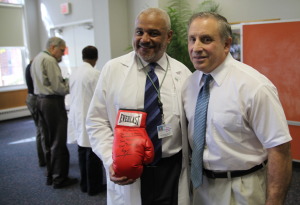At 63, Ray Ciancaglini still has the trim, muscular, compact build of a middleweight boxer. It has been 40 years since the upstate New Yorker was forced to hang up his boxing gloves and with them retire his dream of becoming a champion like Carmen Basilio, another upstate New Yorker whose epic Friday-night fights on television inspired a 6-year-old Ciancaglini to take up the sport. A member of the Rochester Boxing Hall of Fame, he fought both as an amateur and professionally in a 10-year career.
“My only regret as a boxer is that I didn”™t defeat my toughest opponent,” Ciancaglini told clinical staff who stopped to hear his story recently at Burke Rehabilitation Hospital in White Plains, “and that opponent was a concussion. ”¦ I challenged a concussion and I got beat.”
“Lack of concussion education and peer pressure were my demise,” the ex-boxer told his lunch-hour audience. “I”™ve had 40 years to ponder it.”

As he spoke, Ciancaglini frequently checked a script, his memory guide, set at an upright, nearly eye-level angle on a lectern in front of him so he would not lose his train of thought by looking down. It”™s an aid he has relied on in 20 years of speaking engagements on a personal mission to educate student athletes about concussions and help them avoid the “life-altering mistakes” he made.
“A program like this back in my day would have been so important,” said the ex-boxer, whose large-fisted right hand shook with tremors as he spoke. Ciancaglini suffers from dementia pugilistica and Parkinson”™s syndrome. His brain, he said, will be donated after his death to the Boston University School of Medicine for the study of chronic traumatic encephalopathy, a progressive degenerative brain disease much in the news lately for its devastating impact on former National Football League players.
The program that brought him to Burke Rehabilitation Hospital was recently launched by Barry D. Jordan, a sports neurologist who is the private hospital”™s assistant medical director and former director of its inpatient brain injury program. Jordan has started the Retired Athletes Cognitive Evaluation Center, RACE, to evaluate and treat former athletes who are facing neurological disorders possibly caused by repeated head injury during their careers. He said the new center is collaborating with Mount Sinai Hospital, NewYork-Presbyterian University Hospital of Columbia and Cornell and Molecular Neuroimaging in New Haven, Conn.
Athletes exhibiting brain-related impairment later in life require a specially designed neurological evaluation. The specialized testing and treatment “can be very expensive,” Jordan said, and some tests are not covered by Medicare or commercial insurance. RACE was started with seed money from Burke, but donations to the program are needed, Jordan said, to support Burke”™s commitment to evaluate and treat ex-athletes unable to pay for its costs.
Primarily a program for outpatients, RACE also will allow former athletes to join in clinical research studies at the Burke Medical Research Institute on campus.
On his October visit to White Plains accompanied by his wife, Ciancaglini said he was having one of his good days. “On bad days, I struggle to tie my shoes or I forget the names of my friends,” he said. Those days keep him homebound.
Because of memory lapses, he cannot care alone for his 2-year-old granddaughter. “This is the grim reality of more conditions to come,” he said.
“I”™ve had a headache every day since I was 16,” he said. “I”™m now 63. I”™m constantly in a fog and I battle that every day.”
At 44, the college dropout retired from his research department job at Eastman Kodak in Rochester, disabled by progressive dementia and Parkinson”™s.
Ciancaglini was a heralded teen prospect in what he called his “brutal and demanding sport” when he suffered his first concussion on his way to a unanimous decision in Buffalo. He quickly resumed training after the fight “even though I had a persistent headache and felt fatigued,” he recalled.
Fighting in Syracuse, “In the first round I got my bell rung for the second time in a week,” he said. “I was in such a daze, I didn”™t realize I had lost.”
Ciancaglini said he was suffering from second-impact syndrome, a brain condition he knew nothing about in his boxing days. The common belief then was that a boxer had to be knocked unconscious to get a concussion. “In my opinion, the concussion that presents mild symptoms, that can be the most dangerous,” he said.
Once a good student, Ciancaglini began to struggle in high school with poor grades and behavioral problems. He slept excessively. But dosing himself with aspirin, vitamins and caffeine, he continued boxing, heeding an old-timer”™s advice: “Gut it up. Headaches are a part of boxing.”
“My relentless determination and desire defied all common sense and logic,” he said.
Banned from boxing in New York in 1971 based on the results of an electroencephalogram, Ciancaglini entered the ring in other states “with less regulation or no regulation at all,” he said. “I definitely circumvented a system designed to protect me.” Fighting under assumed names in southern states, “I was a fugitive, you might say.”
“I threw a whole career away for the sake of not missing one fight,” he said. He said he would still pursue a boxing career but would seek immediate medical attention for any symptoms of brain injury.
“Downplaying the problem only increases the chance that an athlete will roll the dice when the wager far exceeds the reward,” Ciancaglini said. That is the hard-learned lesson he shares with student athletes.
“The education part is just so important,” Jordan said. In sports, less than 10 percent of concussions are associated with loss of consciousness, he noted. That can leave athletes like Ray Ciancaglini to think their head injuries are not serious and continue competing.



















